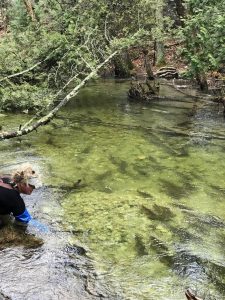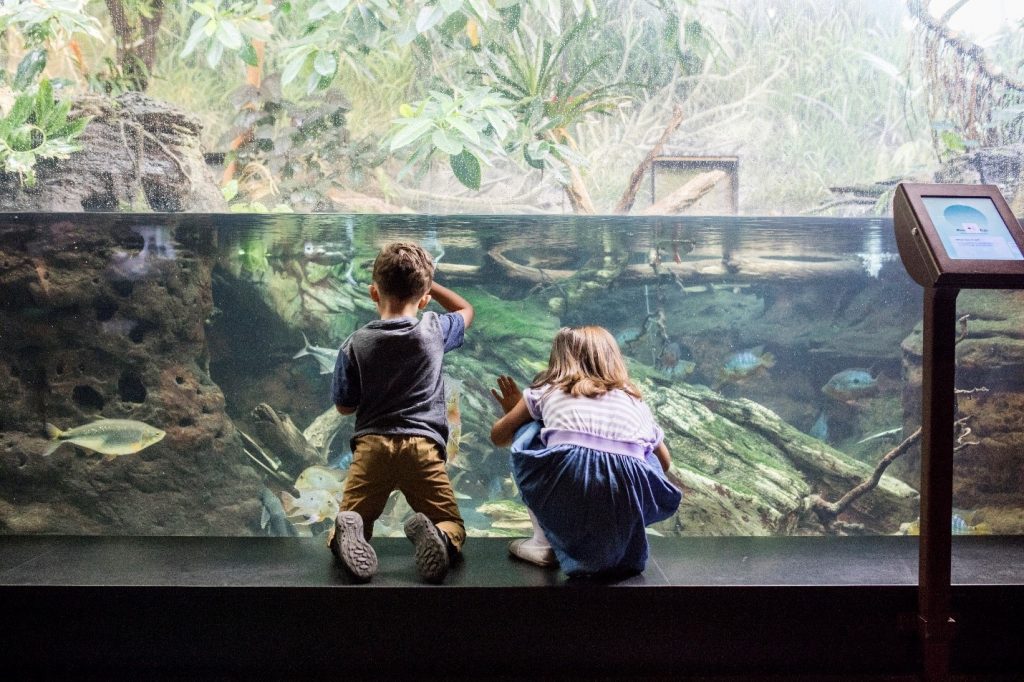In honor of National Zoo and Aquarium month, American Humane is celebrating Humane Certified™ zoological facilities and the incredible work they do to save species, provide life-saving research and education, and inspire millions of visitors each year to protect the animals that they see and interact with. The following blog post was submitted by Shedd Aquarium.
The word “aquarium” usually brings to mind ocean-dwelling species like waddling penguins, glowing corals, and swimming sharks—and Chicago’s Shedd Aquarium is home to all those animals. But guests looking beyond Shedd’s Abbott Oceanarium will see a glittering blue expanse of water much closer to home, Lake Michigan. One of the five Great Lakes, Lake Michigan is an invaluable resource for Chicago, among other cities that sit along its coast. As Shedd introduces its inland visitors to marine animals from across the world, it also pays tribute to these equally beautiful and threatened freshwater ecosystems. In doing so, the aquarium plays an important role in sparking conservation actions.
Stretching over 750 miles, the Great Lakes make up about 20 percent of the world’s freshwater. In addition to providing habitats for over 3,500 species of plants and animals, the Great Lakes are important for humans too! Forty million people use that water for drinking, power, transportation and recreation.
Every component of the ecosystem, from phytoplankton to fish, play a role in keeping the Great Lakes healthy, balanced and available for the people who depend on them. A great example is the role of migratory species, such as suckers (family Catostomidae) that enter tributaries in the spring to spawn, and add nutrients that are passed on to the plants and bugs in those waters. In turn, the plants and bugs support fish, bats, and birds. Sucker migrations impact the whole ecosystem, providing a great example of how each species works with the others to maintain a thriving ecosystem full of biodiversity.
Just as these species work together to keep the Great Lakes healthy, we need to work together to protect the Great Lakes too.
Shedd has research teams, conservation projects and educational exhibits to support this effort, utilizing the aquarium’s wide-reaching voice to engage people with important freshwater species and inspire them to act on their behalf.

Shedd’s own conservation efforts in the Great Lakes involve scientists, researchers and volunteers. Historically, Shedd’s conservation research biologists have kept track of endangered fishes, monitored non-native species and studied near-shore habitat that protects Chicago’s shorelines. The freshwater research team has also been studying the biology and ecology of the threatened mudpuppy population in nearby Wolf Lake, as well as the vital migrations of suckers in Illinois, Wisconsin and Michigan.
In addition to conducting applied conservation research, Shedd brings the wonder of the Great Lakes to 2 million guests annually in the exhibit “At Home on the Great Lakes.” Here, visitors can get an up-close look at 60 species who call the Great Lakes home. They can check out the native lake sturgeons (Acipenser fulvescens) and feel their armor-like plates, and take a look at some invasive species, like the infamous Asian carp and the toothy sea lampreys (Petromyzon marinus). By looking these local species in the eye, guests are inspired to protect local waterways.
The combination of applied research and public engagement is what makes public aquariums unique in their ability to engage the general public and spark conservation. This is a topic two of Shedd’s research biologists, Dr. Karen Murchie and Dr. Chuck Knapp, discussed in a manuscript that was published this spring in the journal Fisheries. The paper underscores the need and challenges for conserving often underappreciated freshwater species and habitats. It also suggests freshwater biologists and managers in the government and universities sectors utilize the sheer numbers and diverse makeup of public aquarium audiences by working with aquariums to advance shared conservation goals. This paper highlights the role and importance of aquariums in fostering appreciation for freshwater biodiversity, like that in the Great Lakes.
As a public aquarium, Shedd looks to spark compassion, curiosity and conservation for the aquatic animal world. In addition to being a great place to see aquatic life that we otherwise wouldn’t, aquariums are also champions for protecting wildlife around the world. Shedd is proud to be part of the zoo and aquarium community to celebrate National Zoo and Aquarium Month where, together, we can be both an educational resource and a catalyst for wildlife conservation.
For more information about Shedd Aquarium’s Great Lakes conservation work, visit www.sheddaquarium.org/conservation.


